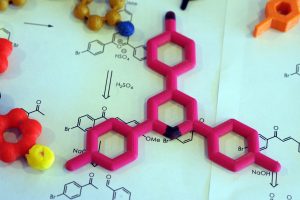CUREs in Large Introductory Labs
HOW HAVE WE SCALED UP CUREs IN OUR LARGE INTRODUCTORY LABS TO ACCOMMODATE UP TO 50 SECTIONS PER YEAR?
Step 1. Lab Director and Researcher collaborate to find a research project that provides opportunities for many hands to participate in over many years.
Step 2. Lab Director develops course design and day-to-day activities with consultation from the researcher and help from TAs.
Step 3. A pilot is run with one or a few sections during summer school.
.
Step 4. Communication tools, such as videos, are developed to ensure the student can “meet” the researcher they are collaborating with in their research project.
.
Step 5. Course is tweaked and expanded to more section over the academic year. Graduate Research Consultants are added to some class sessions (in addition to TAs) to help mentor students through research.
INTRODUCTORY BIOLOGY
Students will be collaborating in an ongoing research project with Dr. Elizabeth Shank, a scientist in the Biology Department. Specifically, the Shank lab is interested in studying how different bacteria interact via small molecules produced by microbes. These molecules are important sources of therapeutic drugs for humans, and include antibiotics, antifungals, anticancer drugs, and immunosuppressive agents which most students connect to. The goal for the students in the course is to discover new small molecules secreted from soil microorganisms through the co-culture screening that students perform on many soil samples. Students will experience iteration by performing many screens on many samples and collaborate with each other to answer questions. In addition to using this type of co-culture screening, students will also use microbiology techniques such as plate streaking, isolating pure cultures, performing serial dilutions of bacteria to determine cell density and using fluorescent microscopy to help identify soil microbes.
Questions about our Biology lab courses? Contact our Lab Director Barbara Stegenga.
INTRODUCTORY CHEMISTRY
Students will be working in collaboration with a real-time outreach project related to solar fuels, funded by the NSF Center for Chemical Innovation and the Camille & Henry Dreyfus Foundation, Inc. Students will be collaborators with UNC’s Dr. Jillian Dempsey and her research team on a project, known as HARPOON (Heterogeneous Anodes Rapidly Perused for Oxygen Over potential Neutralization).
Students will screen nonprecious metal oxides to find combinations and concentrations that function as catalysts to split water for use as a solar fuel. The project allows students to develop their own focused research questions and hypotheses about the most promising metals and combinations. Through this project, students will run experiments using electrochemistry and fluorescence spectroscopy. Students will collaborate in teams and will submit their experimental results and research papers to the growing HARPOON database.
Questions about our Introductory Chemistry lab courses?
“We have 200 undergraduates making these dyes,” Nicewicz says. “It’s easy chemistry, and they’re using household items.”
The process involves designing simple reactions that students can complete in a single step. They pick different points to vary within the structure of the dye, and in the process, invent many slightly different dyes. “Then we can evaluate those to see which combinations produce better reactivity.”
ORGANIC CHEMISTRY
 Students will be working in collaboration with an ongoing UNC Chemistry research project with Dr. David Nicewicz and his research team on the syntheses and analyses of pyrylium salts. Pyrylium salts are brightly colored molecules that have found use in the developing field of photoredox catalysis. Their utility comes from their ability to absorb visible light and enter higher energy excited electronic states. An important factor in using pyrylium salts is the wavelength of light that they absorb. The absorption spectra of these pyryliums are dependent on the substituents present on the phenyl rings. The goal of this project is to synthesize a library of pyrylium bisulfate salts and characterize them since little is known about their catalytic properties. A module will include the synthesis and purification of chalcones and conversion of chalcones to pyrylium salts. The pyrylium salts will be analyzed using NMR, UV-Vis, and fluorescence spectroscopy and cyclic voltammetry. These salts will be tested for catalytic efficacy in an alcohol oxidation reaction. Students will work in teams and prepare research papers describing their work.
Students will be working in collaboration with an ongoing UNC Chemistry research project with Dr. David Nicewicz and his research team on the syntheses and analyses of pyrylium salts. Pyrylium salts are brightly colored molecules that have found use in the developing field of photoredox catalysis. Their utility comes from their ability to absorb visible light and enter higher energy excited electronic states. An important factor in using pyrylium salts is the wavelength of light that they absorb. The absorption spectra of these pyryliums are dependent on the substituents present on the phenyl rings. The goal of this project is to synthesize a library of pyrylium bisulfate salts and characterize them since little is known about their catalytic properties. A module will include the synthesis and purification of chalcones and conversion of chalcones to pyrylium salts. The pyrylium salts will be analyzed using NMR, UV-Vis, and fluorescence spectroscopy and cyclic voltammetry. These salts will be tested for catalytic efficacy in an alcohol oxidation reaction. Students will work in teams and prepare research papers describing their work.
Questions about our Chemistry lab courses? Contact Nita Esksew.
